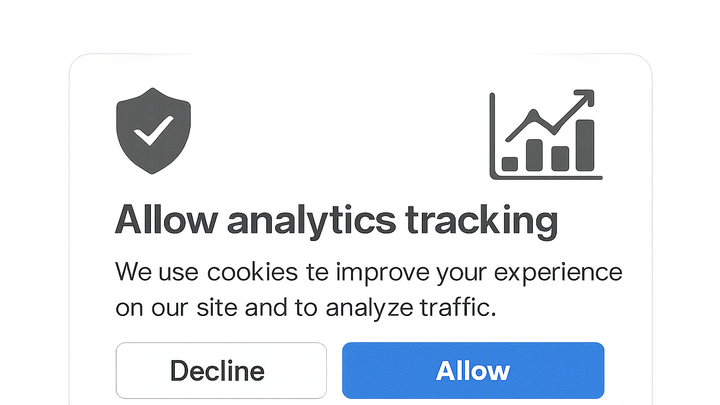Published on 2025-06-28T06:46:26Z
What is Data Consent? Definition and Examples in Analytics
Data consent in analytics refers to obtaining clear and informed permission from website visitors before tracking or processing their personal data. This practice is a cornerstone of modern privacy regulations like the EU’s GDPR, the California CCPA, and other global data protection laws. By securing user consent, organizations ensure legal compliance and build trust with their audience, leading to higher-quality data and better user experiences. Data consent workflows can range from simple banners to comprehensive preference centers. Analytics platforms like Google Analytics 4 and privacy-first tools like PlainSignal provide built-in options to manage consent modes and privacy controls.
Data consent
User permission is required before tracking personal data in analytics for legal compliance and user trust.
Importance of Data Consent
Obtaining data consent is crucial for legal compliance, user trust, and data accuracy. Without explicit consent, organizations risk hefty fines, reputational damage, and unreliable analytics data.
-
Legal compliance
Obtaining explicit consent helps comply with GDPR, CCPA, the ePrivacy Directive, and other global data protection laws, reducing the risk of fines and legal actions.
-
Gdpr requirements
Under the GDPR, consent must be freely given, specific, informed, and unambiguous. Users must be able to withdraw consent as easily as they gave it.
-
Ccpa requirements
The CCPA requires businesses to disclose categories of personal data collected and provides a right to opt-out of the “sale” of personal data.
-
-
Building user trust
Transparent consent practices foster trust, making users more comfortable engaging with your site and sharing data.
-
Data quality
Consent-driven data ensures that collected analytics reflect an audience that has actively agreed to tracking, leading to more accurate insights.
Implementing Data Consent in Analytics Tools
Configure your analytics platforms to respect user consent by leveraging built-in consent modes or integrating consent management solutions.
-
Google analytics 4 (GA4)
GA4 offers a Consent Mode API that adjusts data collection based on user permissions.
-
Consent mode configuration
Example of enabling consent mode in GA4:
gtag('consent', 'default', { 'ad_storage': 'denied', 'analytics_storage': 'denied' }); -
Default consent state
Define default states for
ad_storageandanalytics_storageuntil users grant or deny consent.
-
-
PlainSignal (cookie-free analytics)
PlainSignal is a privacy-first, cookie-free analytics tool that can be configured to initialize only after user consent.
-
Implementation example
Add the following snippet to your site’s head section:
<link rel="preconnect" href="//eu.plainsignal.com/" crossorigin /> <script defer data-do="yourwebsitedomain.com" data-id="0GQV1xmtzQQ" data-api="//eu.plainsignal.com" src="//cdn.plainsignal.com/plainsignal-min.js"></script> -
Consent banner integration
Integrate PlainSignal with a CMP (e.g., Cookiebot) to trigger analytics only after the user opts in.
-
Best Practices for Managing Data Consent
Adopt clear, user-centric consent flows and maintain ongoing compliance with privacy regulations.
-
Clear and accessible notices
Use concise, jargon-free language in consent banners and notices to clearly explain what data is collected and why.
-
Granular consent options
Allow users to opt into or out of specific categories like analytics, marketing, and preferences.
-
Easy withdrawal process
Provide a straightforward mechanism (such as a link in your privacy policy) for users to change or withdraw consent at any time.
